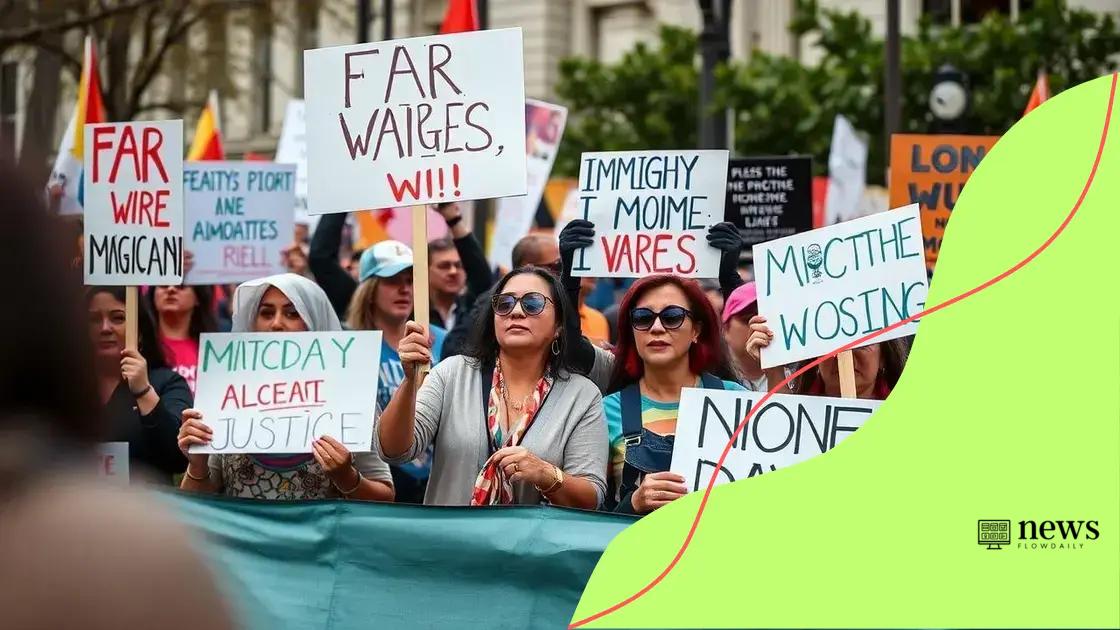May Day protests nationwide: what you need to know

May Day protests nationwide focus on advocating for workers’ rights, social justice, and economic equality, highlighting key issues like fair wages and sustainable practices while utilizing social media for mobilization and engagement.
May Day protests nationwide offer a unique glimpse into the collective voice of workers. Have you ever wondered how these events impact social change? Let’s dive into their significance.
Understanding the significance of May Day
Understanding the significance of May Day provides insight into worker rights and solidarity. It is a day celebrated in many countries around the world, often linked to a rich history of labor movements. The day stands out as a crucial moment for advocating for fair wages and better working conditions.
The Historical Context
May Day originally stems from the late 19th century, particularly highlighted by the Haymarket affair in Chicago in 1886. Workers organized strikes, demanding an eight-hour workday. This pivotal moment catalyzed future labor movements.
Today, May Day is a time to reflect on the struggles that workers have faced. It serves not only as a celebration but also as a reminder of the ongoing challenges. The link between past events and current labor rights movements remains strong.
Key Themes of May Day
- Worker Rights: Advocating for fair treatment and adequate pay.
- Solidarity: Uniting workers across various sectors and regions.
- Social Justice: Highlighting issues such as income inequality and exploitation.
- Global Movement: Connecting protests and celebrations worldwide.
The importance of May Day cannot be overstated. It brings together diverse groups of people who share a common goal: enhancing the rights and conditions for all workers. As we witness the growing awareness of workers’ rights, May Day becomes a powerful symbol of hope for future progress.
By participating in or simply learning about May Day protests, individuals can gain a deeper understanding of the collective effort to establish a more just society. This day is not just about celebrating achievements but also reigniting the commitment for change.
History of May Day protests
The history of May Day protests is deeply rooted in the struggle for workers’ rights. It traces back to the late 19th century, when workers in the United States began demanding better labor conditions. One of the most significant events that led to the establishment of May Day as a labor celebration was the Haymarket affair in Chicago in 1886.
During this time, labor unions organized rallies advocating for an eight-hour workday. The movement gained momentum as workers united to protest long working hours and unsafe conditions. As protests grew, tensions escalated. On May 4, 1886, a peaceful rally turned violent when a bomb was thrown, resulting in the deaths of both police and civilians.
The Global Adoption of May Day
Following the tragic events in Chicago, other countries adopted May Day as a day to honor workers and advocate for labor rights. Countries around the world started recognizing May 1 as International Workers’ Day. Today, it is celebrated in over 80 nations, emphasizing solidarity among workers.
Key Events in May Day History
- 1886: The Haymarket affair sparks a national movement for labor rights.
- 1889: The Second International declares May 1 as a day for international worker solidarity.
- 1930s: May Day becomes a platform for labor rights activism throughout the Great Depression.
- 1960s-70s: Renewed protests arise, focusing on civil rights, anti-war movements, and workers’ rights.
In recent years, May Day has also been used to highlight various social injustices. Activists have embraced this day to raise awareness about immigration rights, environmental issues, and economic inequality. The evolution of May Day protests reflects the changing nature of the labor movement and its connections to broader social issues.
As labor rights and social justice remain crucial topics today, the legacy of the May Day protests continues to inspire new generations. Understanding this history allows us to appreciate the struggles that have paved the way for the rights workers have today.
Key issues raised during the protests

The key issues raised during the protests highlight the urgent demands of workers and activists. These protests often focus on social justice, labor rights, and economic equality. Each year, May Day serves as a platform to voice these critical considerations.
Among the prominent issues are fair wages and working conditions. Activists stress the need for minimum wage increases and better workplace safety regulations. Many workers are still facing long hours and unsafe environments, and these protests rally for necessary reforms.
Core Themes Expressed
Another significant theme is the fight for immigration rights. Many immigrants work in low-wage jobs, facing exploitation and discrimination. By raising these concerns during May Day, protesters emphasize the need for comprehensive immigration reform and protection for vulnerable workers.
- Income Inequality: Addressing the growing gap between the rich and the poor.
- Labor Rights: Advocating for unionization and collective bargaining.
- Healthcare Access: Demanding affordable healthcare for all workers.
- Anti-Discrimination: Fighting against discrimination based on race, gender, and nationality.
Additionally, environmental justice emerges as a crucial topic during protests. Activists link labor rights with environmental sustainability, arguing that fair treatment of workers is essential for a healthy planet. This perspective encourages a holistic approach to both labor rights and ecological protection.
The demands voiced during May Day protests are not only about labor conditions but also encompass broader social issues that affect communities. Addressing these concerns helps to unite diverse groups, fostering a strong sense of solidarity among workers and activists.
The role of social media in mobilization
The role of social media in mobilization has become increasingly significant, especially in recent years. Platforms like Twitter, Facebook, and Instagram have transformed how activists organize, spread information, and attract supporters. With the click of a button, messages can reach thousands, making it easier to raise awareness about important issues.
Social media allows for real-time communication, which is crucial during protests. Organizers can share updates instantly, ensuring participants receive necessary information about meeting locations or changes in plans. This fast-paced communication keeps everyone connected and informed, fostering a strong sense of community.
Engaging the Community
Another key aspect is how social media engages a wider audience. Hashtags like #MayDay create a central place for conversations about the events. People sharing their experiences and photos encourage others to join the movement. The visual nature of platforms like Instagram makes it easy to capture and share powerful images, amplifying the message.
- Building Networks: Social media helps connect activists across different regions, forming a larger network of support.
- Raising Funds: Crowdfunding campaigns often emerge through social media, allowing groups to gather resources for their causes.
- Increasing Visibility: Issues can gain significant attention from news outlets, increasing public awareness and support.
- Mobilizing Young People: Younger generations are more likely to engage through social media, bringing fresh energy and ideas to protests.
Influencers and public figures also play a critical role in mobilization. When they share messages about social causes, their followers become more aware and often take action themselves. This ability to reach diverse audiences shows the power of social media in amplifying voices that might otherwise go unnoticed.
While social media has its challenges, like misinformation, it remains a vital tool for organizing and mobilizing during protests. The ability to connect, inform, and inspire change has transformed the landscape of activism, making each event like May Day more impactful than ever.
Future of May Day protests in the U.S.
The future of May Day protests in the U.S. holds great potential as movements evolve to address contemporary issues. As society changes, so do the themes and participants of these annual events. Activists are increasingly focused on connecting labor rights with social justice, aiming for a broader impact.
One significant trend is the growing attention to diversity within activism. Organizations are working to ensure that all voices are represented, particularly those often marginalized in labor discussions. This inclusivity can empower more people to advocate for their rights on May Day.
Emerging Issues
As we look ahead, several key issues are likely to shape the agenda of future May Day protests. Climate change, for instance, is becoming a central concern. Workers in various sectors are advocating for sustainable practices while fighting for their rights. This new intersection between labor and environmental issues illustrates the need for a holistic approach to activism.
- Digital Organizing: The rise of social media continues to influence how protests are organized, allowing for swift mobilization of supporters.
- Economic Justice: The calls for fair wages and workers’ rights are expected to persist, especially as inequality remains a pressing issue.
- Public Health: The COVID-19 pandemic highlighted the importance of safe working conditions, and workers are likely to demand ongoing health protections.
- Global Solidarity: Connecting with international labor movements could strengthen local efforts and amplify the message.
Furthermore, young activists are increasingly stepping into leadership roles, bringing fresh perspectives and innovative ideas. Their involvement can lead to new strategies that resonate with younger audiences, ensuring that May Day remains relevant and impactful.
As the landscape of labor rights continues to evolve, the future of May Day protests in the U.S. is one of adaptation and resilience. Activists are committed to addressing current challenges while honoring the legacy of those who fought for worker rights in the past.
FAQ – Frequently Asked Questions about May Day Protests
What is the significance of May Day protests?
May Day protests highlight workers’ rights, social justice, and solidarity, offering a platform to advocate for fair wages and better working conditions.
How have May Day protests evolved over time?
Over time, May Day protests have expanded to include issues like environmental justice and immigration rights, reflecting broader social movements.
What role does social media play in May Day protests?
Social media enhances mobilization by allowing activists to share information quickly, engage audiences, and organize events more effectively.
Who participates in May Day protests?
A diverse group of individuals, including workers, activists, and young people, come together to advocate for various social and labor issues during May Day.





